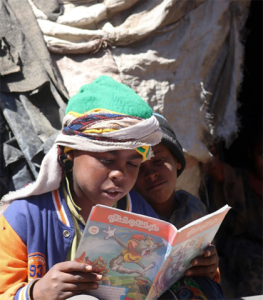Yemen humanitarian crisis rolls on
Seven years after the start of the conflict in Yemen, the nation continues to face a devastating and unrelenting humanitarian crisis.
A new report from the UN’s refugee agency UNHCR says 66 per cent of Yemen’s 30 million people depend on humanitarian assistance for their daily survival. This includes more than 4.2 million internally displaced people (IDPs) and 102,000 refugees and asylum-seekers.
 The ‘2021 Humanitarian Needs Overview’ report says escalation of conflict, ongoing insecurity, embargoes and a collapsed economy have pushed an estimated 80 per cent of the total population below the poverty line and at serious risk of famine.
The ‘2021 Humanitarian Needs Overview’ report says escalation of conflict, ongoing insecurity, embargoes and a collapsed economy have pushed an estimated 80 per cent of the total population below the poverty line and at serious risk of famine.
It says IDPs are at significantly more risk of food insecurity than other Yemenis.
“Internal displacement remains one of the defining features of the Yemen crisis. During 2021 alone, over 157,000 Yemenis were forced to flee their homes due to conflict, particularly in Marib, Taizz, Al-Hudaydah and Al-Bayda governorates,” the report said.
“With ongoing and unrelenting hostilities, and in the absence of a negotiated political settlement, the trend of new and protracted displacement is expected to continue in 2022,” it said.
“While opportunities for safe and dignified returns of IDPs may emerge in stable areas, the current socio-economic and security situation and the lack of public services raise concern about the voluntary and sustainable character of returns.”
The report said the protection environment throughout the country remains dire.
“Civilians continue to pay the highest price of the widespread violations of international humanitarian law by parties to the conflict,” it said.
“With displaced women, children, older people, people with disabilities, and other marginalized groups facing heightened protection risks due to the multiple effects of the conflict, weak rule of law, and the deterioration of their socio-economic conditions as displacement becomes increasingly protracted,” the report said.
The UNHCR is struggling to ensure the protection and well-being of some 102,000 refugees and asylum-seekers across Yemen, mainly from Somalia and Ethiopia.
“Refugees and asylum-seekers pay the toll of a deteriorating socio-economic situation, continue to rely on humanitarian assistance, and are often seen as an additional burden on already overstretched public services,” the report said.
COVID-19 protocols are blocking the resumption of assisted returns to Somalia, and the deterioration in the security situation in Ethiopia has reduced opportunities for voluntary and safe repatriation, even though new data included in the report shows an increase in the number of asylum-seekers arriving in Yemen, including from Tigray.
While arrivals to the country from the East and Horn of Africa mostly people seeking to move on, asylum trends are expected to increase in 2022, the report said.
UNHCR expects Yemen to remain a difficult place in which to operates, with bureaucratic hurdles, attempts by authorities to interfere in humanitarian activities, and security-related obstacles hindering access and shrinking the space for humanitarian interventions.
The report said 2021 marked the seventh year of an ongoing conflict in Yemen that pushed the country to the edge of famine, displaced thousands of people from their homes and rendered half of the country’s public health system dysfunctional.
Read more here: https://reporting.unhcr.org/yemen#toc-narratives












